Being on the southwest side of the Appalachian Mountains, Kentucky is full of lush forests and green spaces. Kentucky is, therefore, home to many species of mushrooms since they’re essential to forest ecosystems.
In fact, mushrooms are necessary for every kind of ecosystem, so there’s a chance that you can find mushrooms growing in your backyard or local park! There are tons of great opportunities for mushroom hunting in Kentucky. Once you know how to get involved and where to be looking, a whole world opens up!
In this article, I’ll describe a few local mushroom species to look out for, where and when to go, and lots of resources to get you started!
Getting Involved
Learning to identify and find mushrooms is a whole new skill to learn. Some people get intimidated by how much there is to learn and never take the leap to actually start. Instead of being overwhelmed by how much you don’t know, embrace all the new knowledge you’re about to gain!
In many ways, mushroom hunting is a slow skill. It takes hours of walking through the forest to find mushrooms and years to build up knowledge about the species. That’s precisely what so many of us love about mushroom hunting!
Also, because the skills and knowledge take a long time to build up, mushroom hunting involves community. One of the best things to get started is to join a local group of mushroom hunters.
This way, you can meet people that have been hunting for years and know the local tricks, you get help from experts when identifying mushrooms, and you can go on hunts with other people – which is safer and more fun!
In Kentucky, there are Facebook groups like the Bluegrass Mycological Society and Eastern Kentucky Morel Mushroom Hunting. Here you can talk with other mushroom hunters / enthusiasts and get updates on local spots or when the season starts.
Resources for Kentucky Mushroom Hunting
In this article, I’ll introduce a lot of information about mushroom hunting in Kentucky, but there’s always more to learn! You should use several different resources to study mushrooms so you can get a general idea.
Mycology – the study of mushrooms – is a young field and there’s still lots of debate about names, habitats, and taxonomy. So, it can be confusing sometimes but just reach out to an expert for clarification!
The University of Kentucky has uploaded many online resources for learning more about mushrooms and how to identify them!
- Their Intro to Fungi page has two informational videos explaining what kind of fungi mushrooms are and how they grow.
- They have another page called What’s That Fungus? with many short videos on different mushroom species growing in Kentucky and identifying them.
- Lastly, there’s also a page on growing your own mushrooms, if you’re interested in cultivating!
Along with local groups, another way to meet other “mushroomers” is going to the annual Mountain Mushroom Festival! Irvine, Kentucky hosts an amazing mushroom festival at the end of April – which is prime morel season! Here you can learn about cooking and crafting with mushrooms, meet other hunters, and enjoy live music and festivities.
Laws and Rules for Mushroom Hunting
One of the first things you should learn when starting to mushroom hunt is where you can legally collect mushrooms. It’s not a free-for-all and there are some protected areas where you can be fined or jailed for picking mushrooms.
These rules are in place to keep people from taking too much from the land and for safety reasons. Respect the laws so that we all can continue to mushroom hunt! Reckless mushroom hunting puts a negative image on the whole mushroom-hunting community, making it harder for everyone.
The following rules only apply to collecting mushrooms for personal use. If you wish to collect mushrooms to sell them, you’ll need a special permit.
Collecting mushrooms is allowed in National Forests, with a maximum of one gallon of mushroom per person and per day. You don’t need a permit to collect mushrooms unless you plan to collect more than one gallon.
It’s also okay to collect mushrooms in Wildlife Management Areas in Kentucky. However, these rules are subject to change, so be aware of seasonal updates. If you’re unsure, it’s always better to call ahead and get explicit permission.
You’ll need to call for city and county parks since they each have their own jurisdiction and therefore different rules.
To hunt on private property you need explicit permission from the owner. Most people don’t mind, so it’s best to just ask. This, of course, means that you can collect any mushrooms on your property!
Foraging Rules and Tips
It’s important to collect mushrooms legally, but also to do so responsibly. Mushrooms – and fungi in general – play an important role in their ecosystems. So, if we take too many or disrupt their ability to reproduce, there are consequences for all the other living beings that rely on fungi – including us!
So, first off, only take as many mushrooms as you’ll actually use. This seems obvious, but remember this when you find your first patch. If you come across 15 to 20 mushrooms, this can be super exciting! However, be realistic and if you’re not going to eat all 20, don’t take all 20.
When mushroom hunting, keep your eyes open. Many mushrooms grow in groups in the same area, so if you’ve found one there’s probably more around! At the same time, don’t get tunnel vision and forget to look out for snakes or poison ivy, for example.
In general, be respectful and don’t disturb the environment. By collecting mushrooms, you’re already taking something from the forest, don’t damage the habitat while you’re at it! There’s no need to break down branches or stomp on plants while you’re hunting.
Also, here are a few tips to make your hunt smoother:
- Dress accordingly. Sturdy boots or shoes, maybe rain boots, because you’ll be walking for a while and enough layers to stay warm.
- Bring what you need. Pack enough water, and bring a field guide or a notebook, or even a compass if you plan to go far off trail.
- Use a mesh bag or wicker basket. These materials are loose and allow good air circulation to keep your mushrooms fresh. Never carry mushrooms in a plastic bag because they will wilt quickly.

When mushroom hunting be respectful of the environment and only take what you will actually use.
©Grusho Anna/Shutterstock.com
Common Edible Mushrooms
Hundreds of mushroom species are growing in Kentucky, so you need to know which ones to search for. There’s a small percentage of mushrooms that are edible and enjoyable to eat – most have strange tastes or textures. Thankfully, these “choice edibles” are fairly common to come by!
Even for the completely edible species, you always need to cook wild mushrooms. Because mushrooms absorb toxins from their environment, you should never eat a mushroom raw. When you cook a mushroom, harsh minerals or toxins can be cooked out or evaporated.
For the same reason, only pick mushrooms from clean spaces. Mushrooms growing near roads or chemical runoffs will absorb all kinds of junk that make their edibility questionable. Even cooking them might not clear out the toxins.
Now that you know how to pick mushrooms, let’s get into which edible species you’ll be hunting!
Morels (Morchella spp.)
Morels are one of the most well-known species of mushrooms because they’re super tasty. It’s agreed (almost) across the board that morels are one of the best culinary mushrooms in the world.
Plus, it helps that they’re easy to identify: Morel mushrooms have a strange cap with deep ridges that resemble a honeycomb. There are several species in the Morchella genus and they’re all edible when cooked!
While it’s easy to identify a morel, it’s not easy to spot one. These mushrooms are only three to five inches tall. Usually, they just barely pop above the layer of leaves on the forest floor.
Also, morels don’t have a specific habitat. They often grow in forests with dead elm or apple trees, but they’re not necessarily always in these places. The mountains of eastern Kentucky are known to be good spots! You can use this map as a guide to see where people have recently spotted morels.
Morels, also called “Hickory Chickens” in Kentucky, are spring mushrooms. They begin to pop up in March and will continue up to May as long as there’s enough rain. Your best bet for hunting morel mushrooms is to go out one or two days after spring rain.

Morel mushrooms have a strange cap with deep ridges that resemble a honeycomb.
©Mircea Costina/Shutterstock.com
Chanterelles (Cantharellus spp.)
Chanterelles are also well-known edible mushroom, both because of their taste and how commonly they’re found. There are about 15 species of Cantharellus that are all edible Chanterelle mushrooms, plus some species of Craterellus are considered Chanterelles.
The golden chanterelle is one of the most popular species, so most people associate chanterelles with this bright orange species, but the color can vary depending on the species.
Chanterelles grow as individual mushrooms but also in groups, so there’s always more around! They like to grow with hardwood trees, especially hemlock, oak, and hickory.
You’ll find these mushrooms towards the end of the summer, as temperatures cool down a bit. They can be found sooner when the summer is mild. A very dry summer will cause their “season” to start later, usually after the first fall rains.
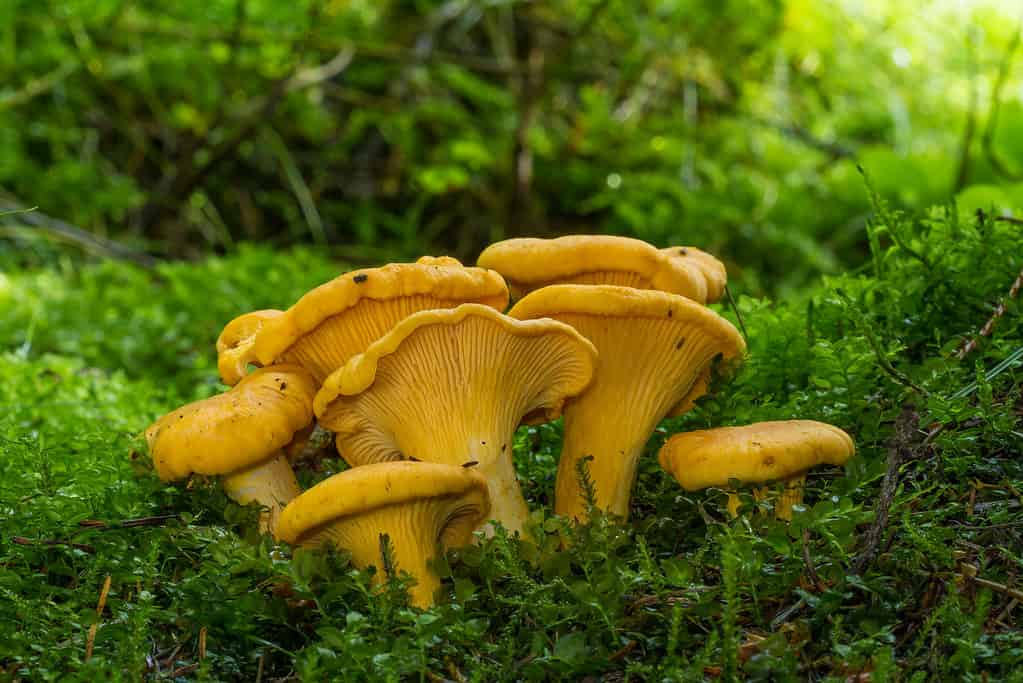
There are about 15 species of
Cantharellusthat are all edible, but the golden chanterelle is one of the most popular.
©godi photo/Shutterstock.com
Medicinal Mushrooms
As more and more promising research is coming out, more people are learning about the medicinal benefits of mushrooms. Some are linked to increased memory retention, focus, or immune-system functioning.
I can’t promise here that any of these mushrooms will improve certain conditions or that they will work how they’re said to, you can research and decide for yourself. But, it’s pretty exciting that you can forage for medicinal mushrooms! Here are two that are easy to identify.
Reishi (Ganoderma sessile, G. lucidum)
Reishi mushrooms have been used in traditional Chinese medicine for thousands of years and are believed to improve liver and immune system functions. It’s edible and can be safely ingested but it’s not very tasty, so reishi mushrooms are usually dried and used as powder.
These mushrooms are easy to identify in form and color. Ischnoderma resinosum is considered a lookalike species, but it’s also edible and apparently tastier!
Reishi are “shelf” mushrooms, meaning they grow horizontally out of dead pieces of wood. They’re maroon at the center and fade outwards to dark orange with white tips. The underside is white and becomes gray as it ages, but you want to pick a younger mushroom that will be softer.
Reishi mushrooms can grow from May until November as long as there’s enough rain. They decompose pieces of dead hardwood trees, often oak, elm, or beech trees. These mushrooms will fruit on the same piece year after year until it’s completely decomposed- so you can come back to the same spot!
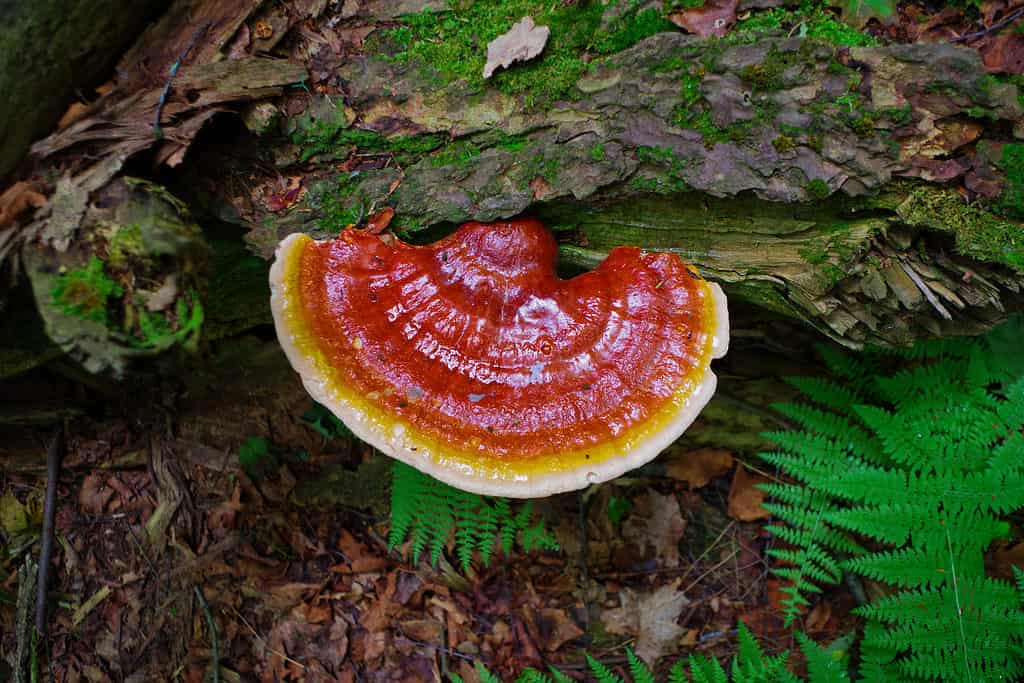
Reishi are “shelf” mushrooms, meaning they grow horizontally out of dead pieces of wood.
©James Aloysius Mahan V/Shutterstock.com
Lion’s Mane (Hericium erinaceus, H. coralloides, H. americanum)
Lion‘s mane mushrooms are supposedly pretty tasty and many people collect them primarily for the table. However, these mushrooms have been associated with lower levels of anxiety and increased cognitive function and memory retention.
These mushrooms are pretty easy to identify once you’ve spotted one. They grow into a large white mass from a piece of dead wood. They become yellowish over time, so only pick the younger specimens that are white. These chunks of mushrooms have long, thin spines that resemble hairs, giving them the name “lion’s mane”.
They usually grow on fallen pieces of dead hardwood trees or the stumps. Lion’s mane can be found in late summer to early winter.
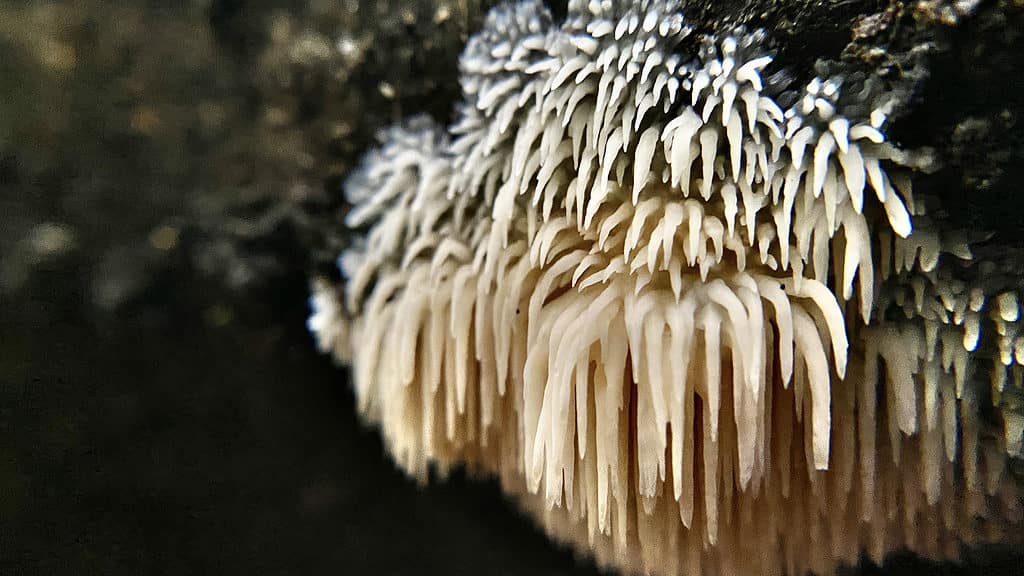
The lion’s mane mushroom gets its name from its long, thin spines that resemble hairs.
©iStock.com/samuel howell
Common Toxic Mushrooms
It’s also crucial, especially for beginner mushroom hunters, to learn about the highly toxic species. Once you know which species you should absolutely avoid, you can more easily narrow down what species you’ve found.
Here are a few species that are fatally toxic that you might come across. This is not a definitive list of all toxic mushrooms in Kentucky, but it’s good to start with the deadly mushrooms!
Destroying Angel (Amanita bisporigera)
The Amanita bisporigera does not live down to its name. This mushroom is one of the most toxic that can be found in Kentucky but luckily it’s fairly easy to identify.
The name “destroying angel” may sound paradoxical, but this mushroom does have an angelic look. It’s pure white from head to toe, or rather from the ground to the tips of its cap. Sometimes they have a pale pink or yellow tint to their cap, but you can’t mistake their bright white looks.
They’re very large mushrooms that are several inches tall and wide, once their cap is fully opened. Destroying angel mushrooms grow individually, although there are often others nearby.
These mushrooms grow from mid-summer to late fall, as long as they’re receiving enough rainfall. Destroying angel mushrooms grow in moist environments, often forests with hardwoods, especially oaks.
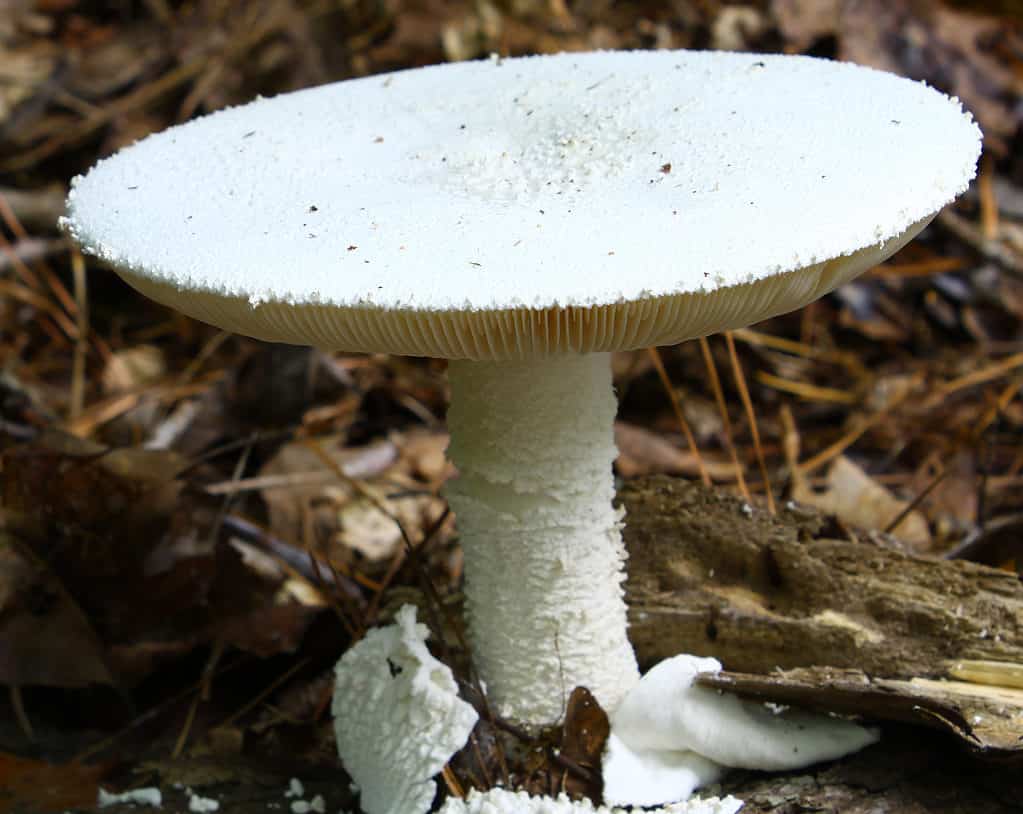
Destroying angels are large mushrooms which are pure white from the ground to the tips of its cap.
©Barry Blackburn/Shutterstock.com
Deadly Galerinas (Galerina spp.)
Although not every species in the Galerina genus is toxic, it’s usually recommended to avoid all of these mushrooms. That’s because many of the species resemble each other so it’s difficult to distinguish exact species. Regardless, none of the Galerina mushrooms are edible so you don’t want to be ingesting these anyways!
Of course, the looks and growing habit varies a lot depending on the species, but in general Galerina mushrooms are brown and tiny. They’re often grouped into the broad category of Little Brown Mushrooms (LBMs) because they don’t have many distinct features.
Their colors can range from tan, light brown, to dark brown. Galerinas usually grow on dead wood, often in clusters but some grow individually. I know this doesn’t seem helpful for identifying these mushrooms, but that’s the point with galerinas! These mushrooms are the perfect example of why you should avoid vague, inconspicuous mushrooms and only eat the ones that you’re 100% sure of.
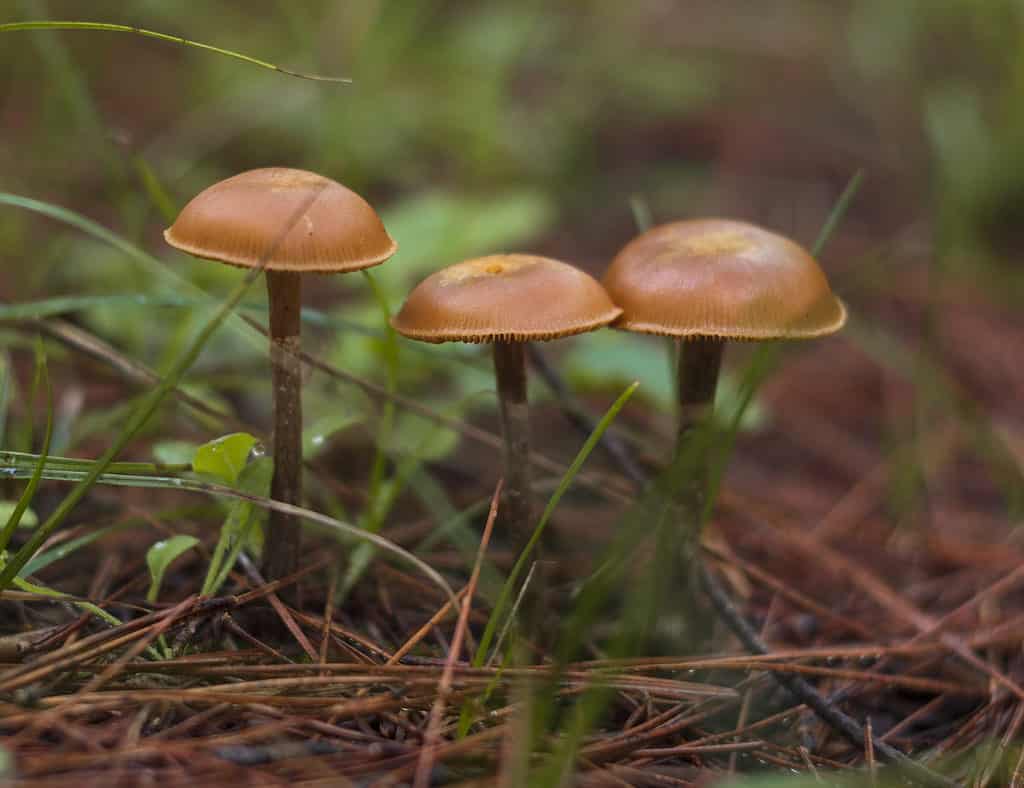
Several species in the
Galerinagenus are extremely poisonous so it is recommended to avoid all of these mushrooms.
©iStock.com/Alika Obrazovskaya
Where to Go Hunting in Kentucky
Now that you know what you’re looking for, let’s talk about where to go looking. Even the larger mushrooms seem tiny when compared to the tall trees that surround them, so it’s easy to feel like you won’t find anything.
The best strategy when mushroom hunting is to search for a particular species. Just like any other living being, every mushroom has its specific habitat where it’s likely to grow. Rather than searching high and low and studying every mushroom you find, go in with a clear idea of where you should be looking.
This dramatically increases your chances of finding what you’re searching for and helps you target your focus. Otherwise, you could be walking around for hours and find nothing. Although, it’s not so bad to walk around the forest for a day!
Eastern Kentucky is known to be rich for mushroom hunting because of the healthy forests at the foothills of the Appalachian Mountains. However, mushrooms can be found all over the state!
Many mushroomers have shared finds from Madisonville, Elizabethtown, and Bowling Green, for example. Plus, Breckinridge county is known to have several great hunting spots. Also, the Mammoth Cave area has lots of healthy trees and soil perfect for mushroom growth!

Kentucky forests like Mammoth Cave National in Park are great spots for mushroom hunting.
©iStock.com/Kevin Hearn
When to Hunt Mushrooms
Just like the question of where to look, when to go hunting is highly dependent on the species and you’ll have the best luck if you go based on a species. There’s a large range of seasons, and factors determining the season for each mushroom, so it makes a big difference if you’re going at the right time of year, or not!
In general, most mushrooms grow in the spring or fall. Some grow during the summer as well, if the weather isn’t too hot and dry. Some species grow year-long (like oyster mushrooms) or that can withstand cold winters (like lion’s mane mushrooms).
All mushrooms need consistent moisture to grow, so a dry spring could mean no mushrooms, even if that’s their normal season. However, each species has many other factors that affect its growth, like soil temperatures, sun exposure, or relations to nearby trees. So, do some research on the exact species you’re hoping to find to learn more about what its preferences are and when to expect it coming!
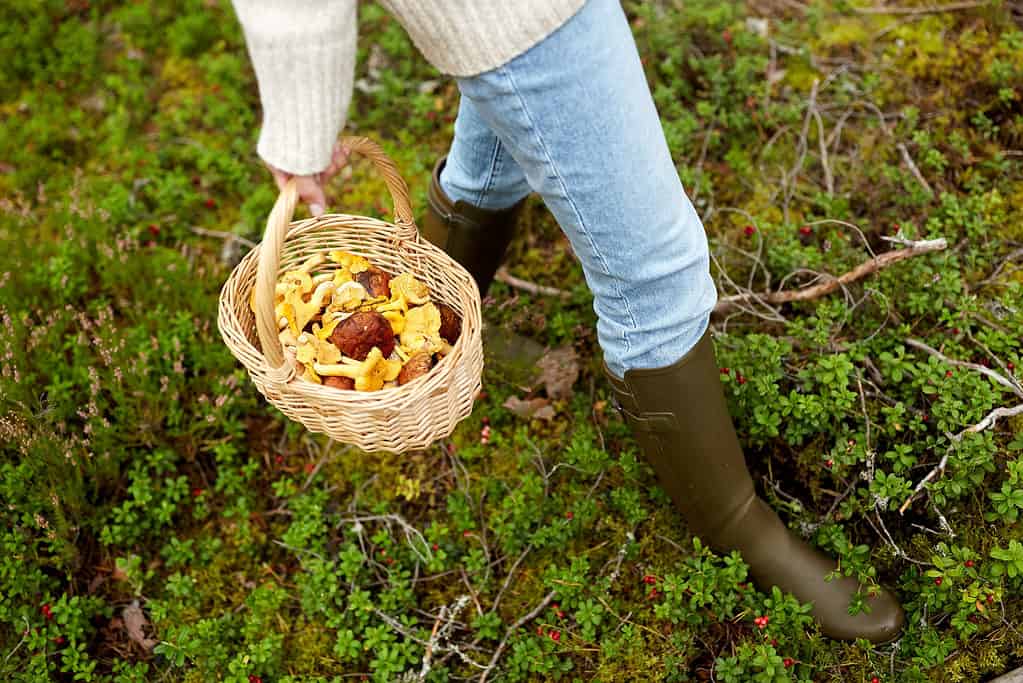
In general, most mushrooms grow in the spring or fall, making these seasons ideal for mushroom hunting.
©iStock.com/dolgachov
Let’s Hunt!
I hope this article helps you feel more confident and prepared to go out mushroom hunting! There’s so much to learn and this article doesn’t cover everything – that would be impossible – so don’t stop here. Make sure to use the resources listed at the beginning of this post and use the help of field guides and local groups.
However, a lot of knowledge is gained from simply going out into the forest and starting to hunt. You definitely shouldn’t eat any mushrooms you can’t positively identify and this means that on your first couple trips you might not bring home any mushrooms.
But this is okay! It takes time to build up this knowledge and practice is the best way to do so. What’s important is that you get started – and you’ll be eating yummy, wild mushrooms before you know it!
Up Next
The photo featured at the top of this post is © iStock.com/PIKSEL
The information presented on or through the Website is made available solely for general informational purposes. We do not warrant the accuracy, completeness, or usefulness of this information. Any reliance you place on such information is strictly at your own risk. We disclaim all liability and responsibility arising from any reliance placed on such materials by you or any other visitor to the Website, or by anyone who may be informed of any of its contents. None of the statements or claims on the Website should be taken as medical advice, health advice, or as confirmation that a plant, fungus, or other item is safe for consumption or will provide any health benefits. Anyone considering the health benefits of particular plant, fungus, or other item should first consult with a doctor or other medical professional. The statements made within this Website have not been evaluated by the Food and Drug Administration. These statements are not intended to diagnose, treat, cure or prevent any disease.
Thank you for reading! Have some feedback for us? Contact the AZ Animals editorial team.






